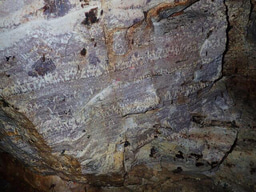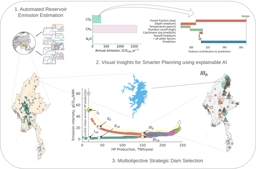Returning water to gold mining ravaged forests: reconsidering approaches to reforestation
Published in Earth & Environment

The impact of a journey through the landscape of alluvial gold mining in the Amazon rainforest is hard to put into words, or capture fully in even the most striking photographs. There was an acute feeling of ecological grief as we crossed from the pristine rainforest in Tambopata National Park–one of the biodiversity hotspots of the world–into a desert wasteland of old mining tailings and ponds. As a disturbance hydrologist, I spend a lot of time thinking about the way natural and anthropogenic changes around the world can completely alter a landscape, but the scars here were so fresh that the sadness felt aching. When processing the data and writing the associated paper, I felt a stark dissonance between the realities of our study region and the need to use sanitized language to describe it in academic writing.
Artisanal and small-scale gold mining of ancient riverbeds–a common practice in the Madre de Dios region of Peru–is profoundly ecologically damaging. It involves deforesting large swaths of landscape, washing away the topsoils to be carried down once clear, now turbid rivers, and sluicing remaining sands to extract any gold present. This gold is then amalgamated with mercury–in the illegal mining regions, that mercury is often dumped and left to move through the landscape. When the gold is burned in furnaces in nearby towns, the mercury is burned off and deposited atmospherically to infiltrate the ecosystems and the humans who live there. High levels of mercury, a dangerous neurotoxin, have been found in people, birds, fish and rivers across the Madre de Dios region.
Beyond the ecological impact, there are devastating effects on the people who work here in conditions that have been termed modern day slavery. The Madre de Dios region was such a hotbed for human trafficking, both for mining and sexual labor, that the Peruvian government executed Operation Mercury in 2019 to try and halt illegal mining activities and associated human trafficking. These conditions were documented by a photographer we traveled with in 2022, Florence Goupil, in a news article entitled “Paradise lost: Inside Peru’s emergency zone” published by NBC. But illegal mining activities accelerated once again during the course of our field visits between 2022 and 2024. Before our last stay in 2024, miners attacked the park ranger station, further heightening tensions within the region. Although being American made us notably safer than local activists, who have been targeted for their conservation work, we always had to remain on guard when staying in town outside of the illegal mining zone.
These difficult conditions for field work are only exacerbated by the harsh physical environment. Deforested areas can get extremely hot, with little shade to provide relief in the clear-cut landscape. Electric resistivity imaging–the technique we used for understanding changes to the subsurface and subsurface water–involves placing metal stakes in the ground and connecting them to push current into the ground and measure the voltage difference. This requires low contact resistances to minimize errors and maximize depth measured. In a clay rich soil, like the tierra firme that occurs naturally in this area, this is no issue. But in dry sand that can’t hold water, it can be maddening to try to lower contact resistances with a combination of cat litter (mostly clay) and salt water applied over and over again (and again) underneath that hot, probing sun. There is also a feeling of constant vigilance that I had never experienced before, as I knew that anyone who drove by was watching and monitoring us. Field work generally is demanding but these trips were a different level of exhaustion.
We were able to use this electrical resistivity data in combination with other field measurements, such as hydraulic conductivity (the rate at which water can move through the surface soils) and continuous soil moisture and temperature loggers, to show that the large scale changes brought about by mining dramatically limit water availability to plants. The soils (sands, really) in the mining area were hot and dry all the time, as water moved through them extremely fast down to 1.5-2m deep. This is extremely inhospitable to new growth, which is why reforestation efforts have largely been stunted and natural regeneration is extremely slow. As a result, we suggest in the paper that large scale reconfiguration of these tailing piles is needed to allow for widespread rehabilitation. At a minimum, reforestation efforts should be focused in areas where they can utilize the water available from tailing ponds. There are miners in legal concessions who are interested in the remediation of their lands and getting them more information on ways to re-establish forests post-mining is important.
All this destruction is driven by the Global North’s desire for increased gold. We want cheap jewelry and use gold as a financial investment without thinking about the profound consequences, both human and ecological, of those choices. The price of gold has been skyrocketing for the past 25 years, corresponding with an ever increasing footprint of deforested hectares in the Madre de Dios. We have a shared responsibility to consider our choices carefully–and look beyond those of financial cost–to protect the health of our planet and preserve irreplaceable resources like tropical rainforests. This research has been deeply moving to me personally as well as intellectually. While I may want to think that my own personal excesses cause only a ripple effect, viewed as a whole, the societal excesses are creating a tsunami of devastation in the regions that supply the Global North with precious metals. I hope that it might reach out to you as well and urge you to at least consider where the gold you wear or buy comes from, and whether it is worth the ecological and human cost.
Follow the Topic
-
Communications Earth & Environment

An open access journal from Nature Portfolio that publishes high-quality research, reviews and commentary in the Earth, environmental and planetary sciences.
Related Collections
With Collections, you can get published faster and increase your visibility.
Geology of the Moon
Publishing Model: Hybrid
Deadline: Jan 31, 2026
Drought
Publishing Model: Hybrid
Deadline: Dec 31, 2025




Please sign in or register for FREE
If you are a registered user on Research Communities by Springer Nature, please sign in